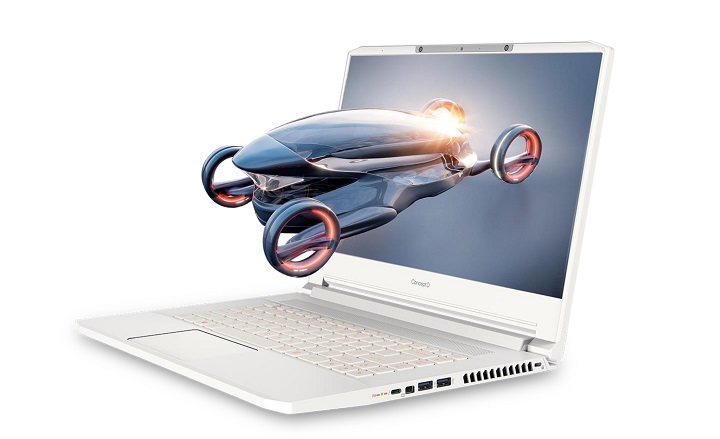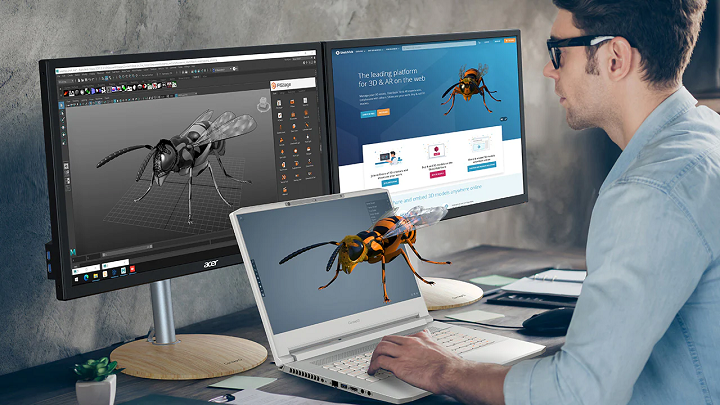Acer has recently announced SpatialLabs, a suite of experiences empowered by advanced optical solutions with display and sensory technologies, delivering stereoscopic 3D experiences.

According to Acer, content literally floats in front of the screen, allowing creators to examine their creations in real-time and 360 degrees without the need for specialized glasses.
Acer also announced the SpatialLabs Developer Program for Unreal Engine developers interested in presenting projects with SpatialLabs. Those enrolled in the program will receive a ConceptD SpatialLabs prototype notebook, the first realization of the new experience.
First unveiled on a ConceptD notebook, SpatialLabs combines an eye-tracking stereo camera, a stereoscopic 3D display, and real-time rendering technologies to provide creators a new way to interact with their creations.
The eye-tracking solution consists of a stereo camera set located on top of the device and tracks the position and movement of a user’s head and eyes. The display of the ConceptD SpatialLabs prototype notebook to be provided to participants of the developer program consists of a UHD 2D panel with a liquid crystal lenticular lens optically bonded on top of it, concurrently forming an innovative module that can be switched back and forth between 2D and stereoscopic 3D views.

Together, this enables graphics processing technology to display a different image to each of a viewer’s eyes, creating a stereoscopic 3D effect that allows content to float in front of the screen. In addition, real-time rendering technologies allow creators to interact with 3D models when using applications in the SpatialLabs Experience Center to review their creations in real-time, enhance the design workflow, and present interactive and immersive projects in stereoscopic 3D.
Meanwhile, the ConceptD SpatialLabs prototype notebook’s display is set to the 2D mode by default, enabling the device to be utilized as a normal notebook computer. However, upon launching applications in the SpatialLabs Experience Center, the stereoscopic 3D mode will be automatically switched on.

The SpatialLabs Experience Center is a launcher that includes a tutorial on using the technology, several shortcuts for applications, and installers for applications and add-ons. These applications include the following:
• SpatialLabs Model Viewer – A tool that enables a user to import files in all major 3D file formats and present them in stereoscopic 3D. While in the model viewer, the information generated about the head position is incorporated into the displayed 3D model. For example, moving slightly to the left or right will rotate the 3D model in the opposite direction, as if a user had taken a step to either side of the object. All of this happens in real-time.
• SpatialLabs Go – A solution for rendering side-by-side full-screen content into stereoscopic 3D. For example, after leveraging Blender to set a window into a side-by-side full-screen view, designers can use SpatialLabs Go to transfer it into stereoscopic 3D.
• PiStage for Maya – The middleware PiStage functions as a tool that allows the time-consuming back-and-forth rendering pipeline to be skipped, giving users the flexibility to create or edit the content on an extended 2D monitor and view any changes made in stereoscopic 3D in real-time, with SpatialLabs.
• SpatialLabs Player – A native player for presenting side-by-side video in stereoscopic 3D.
“Our team is excited about the possibilities with the new ConceptD SpatialLabs prototype notebook and their SpatialLabs Developer Program,” said John Buzzell, the Lead of Enterprise Business Development at Unreal Engine. “When your innovative content and applications combine with the latest in visualization, you get an experience that’s immersive, accessible, and engaging.”
Furthermore, Acer will provide those admitted to the program with a ConceptD SpatialLabs prototype notebook for a period of three months—totally free of charge, freight included. Acer also mentioned that accepted applicants could use the provided device to create projects in Unreal Engine, and in exchange, the applicant should allow Acer to demo and exhibit these project(s) for one year.
Note that user feedback and an interview will also be gathered during the creation process for purposes including product development.
Interested applicants may register through this link. Application closes on June 30, 2021, after which point successful applicants will be contacted.
You may visit the official Acer website for more information.

YugaTech.com is the largest and longest-running technology site in the Philippines. Originally established in October 2002, the site was transformed into a full-fledged technology platform in 2005.
How to transfer, withdraw money from PayPal to GCash
Prices of Starlink satellite in the Philippines
Install Google GBox to Huawei smartphones
Pag-IBIG MP2 online application
How to check PhilHealth contributions online
How to find your SIM card serial number
Globe, PLDT, Converge, Sky: Unli fiber internet plans compared
10 biggest games in the Google Play Store
LTO periodic medical exam for 10-year licenses
Netflix codes to unlock hidden TV shows, movies
Apple, Asus, Cherry Mobile, Huawei, LG, Nokia, Oppo, Samsung, Sony, Vivo, Xiaomi, Lenovo, Infinix Mobile, Pocophone, Honor, iPhone, OnePlus, Tecno, Realme, HTC, Gionee, Kata, IQ00, Redmi, Razer, CloudFone, Motorola, Panasonic, TCL, Wiko
Best Android smartphones between PHP 20,000 - 25,000
Smartphones under PHP 10,000 in the Philippines
Smartphones under PHP 12K Philippines
Best smartphones for kids under PHP 7,000
Smartphones under PHP 15,000 in the Philippines
Best Android smartphones between PHP 15,000 - 20,000
Smartphones under PHP 20,000 in the Philippines
Most affordable 5G phones in the Philippines under PHP 20K
5G smartphones in the Philippines under PHP 16K
Smartphone pricelist Philippines 2024
Smartphone pricelist Philippines 2023
Smartphone pricelist Philippines 2022
Smartphone pricelist Philippines 2021
Smartphone pricelist Philippines 2020